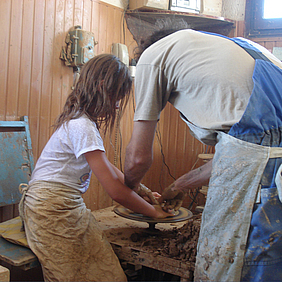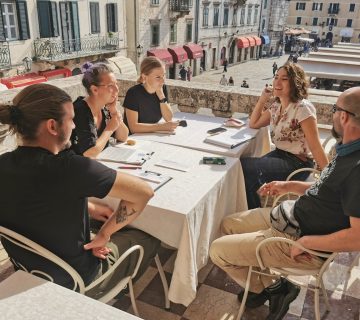Hilly, rocky land, little rain but surrounded by water, immortal plants, wise buildings, stories and customs combining natural and cultural events make Sifnos a great example of guiding focused on nature and cultural heritage
I live in one of the Greek paradises, Sifnos island in Cyclades; an ideal place for combining nature and cultural heritage. Here you realise that you can’t have the one without the other and you can’t talk for the one without talking for the other at the same time.
I’d like to share with you just a few examples, but there are many more.
We live in a rocky place, with less water than we need, and more hills and mountains than we would choose, so cultivation has always been and still is a struggle. The dry-stone walls, everywhere on the island, are ‘just’ stone on a stone, thousands of years old, and they were built in order to create flat pieces of land, keep the little soil and little rain so as to make cultivation possible, separate properties and indicate private from public land. These walls were built to last forever and this is exactly what they do.
Our houses, storehouses, dove houses – in fact, all our buildings – take weather into consideration: the kitchen to the west to be cool; openings to the north to avoid humidity; shade with grapes or jasmine plants; cisterns underground to collect the valuable rain water – that is why we have flat roofs in Cyclades; white walls (traditionally calcium carbonate, an antiseptic material people could make by burning stones) to reflect sunshine. Weather still affects many jobs, even today: agriculture, fishing, trade and transportation (no boat if it is windy), the construction industry, etc.
Local climate has been the excuse for nature to create incredible plants. In Sifnos – ok, in other islands too – there are plants that can grow without any water at all! Tomatoes, string beans, potatoes, chickpeas, fava beans, cucumber, courgette – many plants know what it takes to live without water. They are smaller than massive production products but a hundred times better!
Almost the same with herbs – very strong species grow with a very strong smell because of the lack of water. They are very effective as medicines as well. We still use herbs from the mountains to deal with different health problems.
Many of our customs and religious celebrations have roots in nature and many of them have their origin in ancient times. Christmas is connected to ancient celebrations for Dionysos and the days which start to become longer; the Carnival celebrates the end of cold, winter days; Easter is connected to the new birth for plants.
Our protected plant (not the only one!) in Sifnos is a kind of Cedar tree (Juniperus juniperus) called ‘immortal wood’ in the local dialect. In the past, it was used a lot: the branches and leaves for the pottery kilns, the trunks for the ceilings and sometimes floors. It is a strong plant, like a bush if it is wild, but it can also become a tall tree if you prune it. We say ‘it never dies’ and the proof is visible in Kastro village, with ceilings 800 years old!
On an island, you can’t talk about nature and culture without including the sea. The water around us affects almost everything. People’s character, the feeling of isolation and freedom at the same time, the food and pleasure SHE gives, the captains and sailors SHE accepts and helps, the myths, fairy tales and secrets SHE hides or reveals. There are numberless songs, poems and stories about the sea (not accidentally a female noun in Greek language!)
You see, nature affects culture and culture affects nature so when you try to make people love your place, you can’t separate one from the other.
Ronia is a guide and event planner on Sifnos, Greece. She likes writing and talking about her island, and also looking for different ways to make people see inside it! She can be contacted at: ronia@sifnosevents.gr and also on Facebook.
To cite this article:
Ronia Anastasiadou (2017) ‘When nature and culture become the real, living story’. In Interpret Europe Newsletter 1-2017, 17
Available online:
https://www.interpret-europe.net/fileadmin/Documents/publications/Newsletters/ie-newsletter_2017-1_spring.pdf




